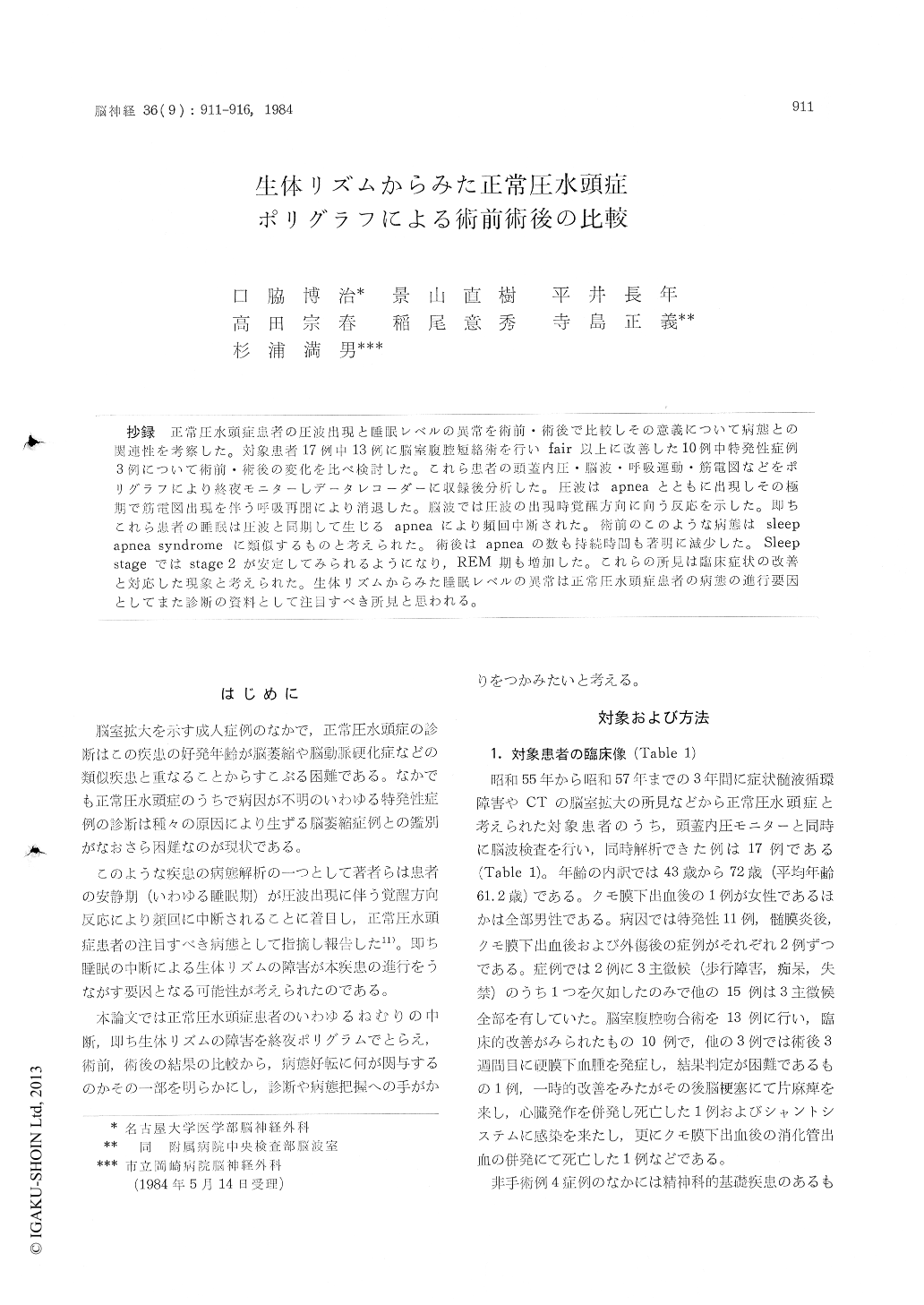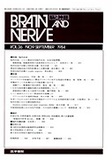Japanese
English
- 有料閲覧
- Abstract 文献概要
- 1ページ目 Look Inside
抄録 正常圧水頭症患者の圧波出現と睡眠レベルの異常を術前・術後で比較しその意義について病態との関連性を考察した。対象患者17例中13例に脳室腹腔短絡術を行いfair以上に改善した10例中特発性症例3例について術前・術後の変化を比べ検討した。これら患者の頭蓋内圧・脳波・呼吸運動・筋電図などをポリグラフにより終夜モニターしデータレコーダーに収録後分析した。圧波はapneaとともに出現しその極期で筋電図出現を伴う呼吸再開により消退した。脳波では圧波の出現時覚醒方向に向う反応を示した。即ちこれら患者の睡眠は圧波と同期して生じるapneaにより頻回中断された。術前のこのような病態はsleepapnea syndromeに類似するものと考えられた。術後はapneaの数も持続時間も著明に減少した。Sleepstageではstage 2が安定してみられるようになり,REM期も増加した。これらの所見は臨床症状の改善と対応した現象と考えられた。生体リズムからみた睡眠レベルの異常は正常圧水頭症患者の病態の進行要因としてまた診断の資料として注目すべき所見と思われる。
The authors had studies the correlation between the appearance of the pressure waves and the level of the sleep in pre- and postoperative patients with normal pressure hydrocephalus (NPH). Thechanges from preoperative findings to postopera-tive ones were discussed in detail with the rela-tion of the pathophysiological state in these patients.
Seventeen patients were evaluated for the sus-pected diagnosis of the disease of NPH. Thirteen patients of them were treated with ventriculo-peritoneal shunts. Four representative cases among them were evaluated by pre- and postoperative polygraphic studies. A polygraphic overnight study includes a monitoring of an intracranial pressure (ICP), electroencephalography (EEG), electroocu-lography (EOG), respiratory movement and elect-romyography (EMG). Each data was recorded for the analysis on data recorder using a computer system.
A pressure waves (largely B type) appeared accompanied with an apnea at a resting state (so-called sleep) of each patients. An arousal response in EEG was also observed in the raising period of the pressure waves. At the peak respiration was resumed with transient activities in EMG and continued to the disappearance of the pressure wave. Pressure waves were observed frequently and contivally in hours in the resting state of these patients. As a result the level of sleep alter-nated frequently between an awake stage and a stage 1, including extremely rare appearance of stage 2.
In short, the level of sleep was frequently inter-rupted by the appearance of the pressure waves and apneas. Such pathological states of patient's sleeps were involved in the entity of the sleep apnea syndrome. After the operation, apneas were extremely rarely observed during the sleep. Then a sleep stage became stable and long period of the stage 2, including an increase in the time of the REM sleep. However, the stage 3 and 4 were hardly found in our follow up studies. These postoperative findings correlated with their impro-vements in the neurological states of the patients with NPH.
In conclusion, the abnormal sleep levels estima-ted by the scale of a biological rhythm seem to be important for the understanding the progres-sion and the diagnosis of normal pressure hydro-cephalus.

Copyright © 1984, Igaku-Shoin Ltd. All rights reserved.


